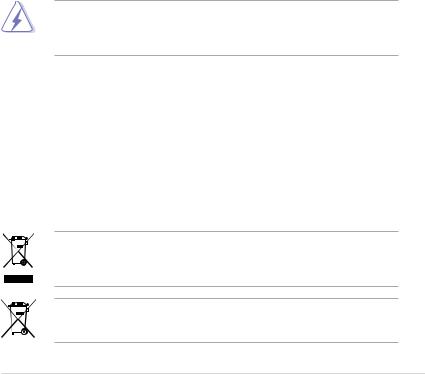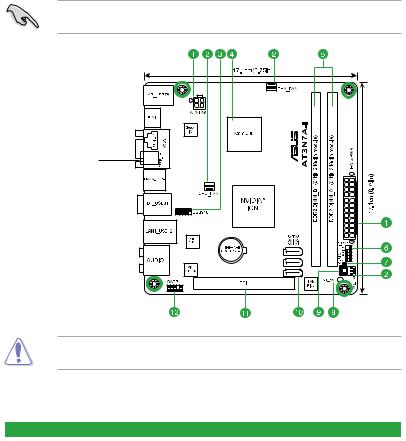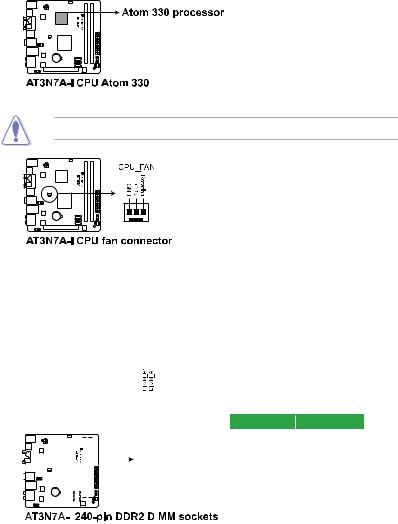ASUS AT3N7A-I User Manual

AT3N7A-I
Motherboard

E4877
First Edition V1
August 2009
Copyright © 2009 ASUSTeK Computer Inc. All Rights Reserved.
No part of this manual, including the products and software described in it, may be reproduced, transmitted, transcribed, stored in a retrieval system, or translated into any language in any form or by any means, except documentation kept by the purchaser for backup purposes, without the express written permission of ASUSTeK Computer Inc. (“ASUS”).
Product warranty or service will not be extended if: (1) the product is repaired, modified or altered, unless such repair, modification of alteration is authorized in writing byASUS; or (2) the serial number of the product is defaced or missing.
ASUS PROVIDES THIS MANUAL “AS IS” WITHOUT WARRANTY OF ANY KIND, EITHER EXPRESS OR IMPLIED, INCLUDING BUT NOT LIMITED TO THE IMPLIED WARRANTIES OR CONDITIONS OF MERCHANTABILITY OR FITNESS FOR A PARTICULAR PURPOSE. IN NO EVENT SHALL ASUS, ITS DIRECTORS, OFFICERS, EMPLOYEES OR AGENTS BE LIABLE FOR ANY INDIRECT, SPECIAL, INCIDENTAL, OR CONSEQUENTIAL DAMAGES (INCLUDING DAMAGES FOR LOSS OF PROFITS, LOSS OF BUSINESS, LOSS OF USE OR DATA, INTERRUPTION OF BUSINESS AND THE LIKE), EVEN IF ASUS HAS BEEN ADVISED OF THE POSSIBILITY OF SUCH DAMAGES ARISING FROM ANY DEFECT OR ERROR IN THIS MANUAL OR PRODUCT.
SPECIFICATIONS AND INFORMATION CONTAINED IN THIS MANUAL ARE FURNISHED FOR INFORMATIONAL USE ONLY, AND ARE SUBJECT TO CHANGE AT ANY TIME WITHOUT NOTICE, AND SHOULD NOT BE CONSTRUED AS A COMMITMENT BY ASUS. ASUS ASSUMES NO RESPONSIBILITY OR LIABILITY FOR ANY ERRORS OR INACCURACIES THAT MAY APPEAR IN THIS MANUAL, INCLUDING THE PRODUCTS AND SOFTWARE DESCRIBED IN IT.
Products and corporate names appearing in this manual may or may not be registered trademarks or copyrights of their respective companies, and are used only for identification or explanation and to the owners’ benefit, without intent to infringe.
ii

Contents
Notices.......................................................................................................... |
v |
Safety information....................................................................................... |
vi |
About this guide......................................................................................... |
vii |
AT3N7A-I specifications summary.......................................................... |
viii |
Chapter 1: |
Product introduction |
|
|
1.1 |
Before you proceed...................................................................... |
1-1 |
|
1.2 |
Motherboard overview................................................................. |
1-2 |
|
|
1.2.1 |
Motherboard layout .......................................................... |
1-2 |
|
1.2.2 |
Layout contents . .............................................................. |
1-2 |
1.3 |
Central Processing Unit (CPU).................................................... |
1-3 |
|
1.4 |
System memory............................................................................ |
1-3 |
|
|
1.4.1 |
Overview .......................................................................... |
1-3 |
|
1.4.2 |
Memory configurations . ................................................... |
1-4 |
1.5 |
Expansion slot.............................................................................. |
1-7 |
|
|
1.5.1 |
Installing an expansion card ............................................ |
1-7 |
|
1.5.2 |
Configuring an expansion card ........................................ |
1-7 |
|
1.5.3 |
PCI slot ............................................................................ |
1-7 |
1.6 |
Jumpers |
......................................................................................... |
1-8 |
1.7 |
Connectors.................................................................................... |
1-9 |
|
|
1.7.1 .................................................... |
Rear panel connectors |
1-9 |
|
1.7.2 ......................................................... |
Internal connectors |
1-11 |
1.8 |
Software ........................................................................support |
1-16 |
|
|
1.8.1 ....................................... |
Installing an operating system |
1-16 |
|
1.8.2 ............................................... |
Support DVD information |
1-16 |
Chapter 2: |
BIOS information |
|
|
2.1 |
Managing and updating your BIOS............................................. |
2-1 |
|
|
2.1.1 |
ASUS Update utility......................................................... |
2-1 |
|
2.1.2 |
ASUS EZ Flash 2............................................................ |
2-2 |
|
2.1.3 |
ASUS CrashFree BIOS................................................... |
2-3 |
2.2 |
BIOS setup program..................................................................... |
2-4 |
|
2.3 |
Main menu..................................................................................... |
2-4 |
|
|
2.3.1 |
System Time.................................................................... |
2-5 |
|
2.3.2 |
System Date.................................................................... |
2-5 |
|
2.3.3 |
SATA 1~3, ESATA............................................................ |
2-5 |
iii

Contents
|
2.3.4 |
Storage Configuration...................................................... |
2-6 |
|
2.3.5 |
System Information.......................................................... |
2-6 |
2.4 |
Advanced menu............................................................................ |
2-6 |
|
|
2.4.1 |
CPU Configuration........................................................... |
2-7 |
|
2.4.2 |
JumperFree Configuration............................................... |
2-7 |
|
2.4.3 |
Chipset............................................................................ |
2-8 |
|
2.4.4 |
Onboard Devices Configuration...................................... |
2-9 |
|
2.4.5 |
USB Configuration........................................................... |
2-9 |
|
2.4.6 |
PCI PnP......................................................................... |
2-10 |
2.5 |
Power menu................................................................................ |
2-10 |
|
|
2.5.1 |
Suspend Mode.............................................................. |
2-10 |
|
2.5.2 |
ACPI 2.0 Support............................................................ |
2-11 |
|
2.5.3 |
ACPI APIC Support........................................................ |
2-11 |
|
2.5.4 |
APM Configuration......................................................... |
2-11 |
|
2.5.5 |
Hardware Monitor........................................................... |
2-11 |
2.6 |
Boot menu................................................................................... |
2-12 |
|
|
2.6.1 |
Boot Device Priority....................................................... |
2-12 |
|
2.6.2 |
Boot Settings Configuration........................................... |
2-12 |
|
2.6.3 |
Security.......................................................................... |
2-13 |
2.7 |
Tools menu.................................................................................. |
2-14 |
|
|
2.7.1 |
ASUS EZ Flash 2.......................................................... |
2-14 |
|
2.7.2 |
Express Gate................................................................. |
2-15 |
|
2.7.3 |
AI NET 2........................................................................ |
2-15 |
2.8 |
Exit menu..................................................................................... |
2-15 |
|
iv

Notices
Federal Communications Commission Statement
This device complies with Part 15 of the FCC Rules. Operation is subject to the following two conditions:
•This device may not cause harmful interference, and
•This device must accept any interference received including interference that may cause undesired operation.
This equipment has been tested and found to comply with the limits for a Class B digital device, pursuant to Part 15 of the FCC Rules. These limits are designed to provide reasonable protection against harmful interference in a residential installation. This equipment generates, uses and can radiate radio frequency energy and, if not installed and used in accordance with manufacturer’s instructions, may cause harmful interference to radio communications. However, there is no guarantee that interference will not occur in a particular installation. If this equipment does cause harmful interference to radio or
television reception, which can be determined by turning the equipment off and on, the user is encouraged to try to correct the interference by one or more of the following measures:
•Reorient or relocate the receiving antenna.
•Increase the separation between the equipment and receiver.
•Connect the equipment to an outlet on a circuit different from that to which the receiver is connected.
•Consult the dealer or an experienced radio/TV technician for help.
The use of shielded cables for connection of the monitor to the graphics card is required to assure compliance with FCC regulations. Changes or modifications to this unit not expressly approved by the party responsible for compliance could void the user’s authority to operate this equipment.
Canadian Department of Communications Statement
This digital apparatus does not exceed the Class B limits for radio noise emissions from digital apparatus set out in the Radio Interference Regulations of the Canadian Department of Communications.
This class B digital apparatus complies with Canadian ICES-003.
REACH
Complying with the REACH (Registration, Evaluation, Authorisation, and Restriction of Chemicals) regulatory framework, we published the chemical substances in our products at ASUS REACH website at http://green.asus.com/english/REACH.htm.
DO NOT throw the motherboard in municipal waste. This product has been designed to enable proper reuse of parts and recycling. This symbol of the crossed out wheeled bin indicates that the product (electrical and electronic equipment) should not be placed in municipal waste. Check local regulations for disposal of electronic products.
DO NOT throw the mercury-containing button cell battery in municipal waste. This symbol of the crossed out wheeled bin indicates that the battery should not be placed in municipal waste.

Safety information
Electrical safety
•To prevent electric shock hazard, disconnect the power cable from the electric outlet before relocating the system.
•When adding or removing devices to or from the system, ensure that the power cables for the devices are unplugged before the signal cables are connected. If possible, disconnect all power cables from the existing system before you add a device.
•Before connecting or removing signal cables from the motherboard, ensure that all power cables are unplugged.
•Seek professional assistance before using an adapter or extension cord. These devices could interrupt the grounding circuit.
•Ensure that your power supply is set to the correct voltage in your area. If you are not sure about the voltage of the electrical outlet you are using, contact your local power company.
•If the power supply is broken, do not try to fix it by yourself. Contact a qualified service technician or your retailer.
•The optical S/PDIF is an optional component (may or may not be included in your motherboard) and is defined as a CLASS 1 LASER PRODUCT.
INVISIBLE LASER RADIATION, AVOID EXPOSURE TO BEAM.
•Never dispose of the battery in fire. It could explode and release harmful substances into the environment.
•Never dispose of the battery with your regular household waste. Take it to a hazardous material collection point.
•Never replace the battery with an incorrect battery type.
• RISK OF EXPLOSION IF BATTERY IS REPLACED BY AN INCORRECT TYPE.
• DISPOSE OF USED BATTERIES ACCORDING TO THE ABOVE BATTERY-RELATED INSTRUCTIONS.
Operation safety
•Before installing the motherboard and adding devices on it, carefully read all the manuals that came with the package.
•Before using the product, ensure that all cables are correctly connected and the power cables are not damaged. If you detect any damage, contact your dealer immediately.
•To avoid short circuits, keep paper clips, screws, and staples away from connectors, slots, sockets and circuitry.
•Avoid dust, humidity, and temperature extremes. Do not place the product in any area where it may become wet.
This motherboard should only be used in environments with ambient temperatures between 5°C (41°F) and 40°C (104°F).
•Place the product on a stable surface.
•If you encounter technical problems with the product, contact a qualified service technician or your retailer.
vi

About this guide
This user guide contains the information you need when installing and configuring the motherboard.
How this guide is organized
This guide contains the following parts:
•Chapter 1: Product introduction
This chapter describes the features of the motherboard and the new technology it supports.
•Chapter 2: BIOS information
This chapter tells how to change system settings through the BIOS Setup menus. Detailed descriptions of the BIOS parameters are also provided.
Conventions used in this guide
To ensure that you perform certain tasks properly, take note of the following symbols used throughout this manual.
DANGER/WARNING: Information to prevent injury to yourself when trying to complete a task.
CAUTION: Information to prevent damage to the components when trying to complete a task.
IMPORTANT: Instructions that you MUST follow to complete a task.
NOTE: Tips and additional information to help you complete a task.
Where to find more information
Refer to the following sources for additional information and for product and software updates.
1.ASUS websites
The ASUS website provides updated information on ASUS hardware and software products. Refer to the ASUS contact information.
2.Optional documentation
Your product package may include optional documentation, such as warranty flyers, that may have been added by your dealer. These documents are not part of the standard package.
Typography
Bold text |
Indicates a menu or an item to select. |
Italics |
Used to emphasize a word or a phrase. |
<Key> |
Keys enclosed in the less-than and greater-than sign means |
|
that you must press the enclosed key. |
|
Example: <Enter> means that you must press the Enter or |
|
Return key. |
<Key1>+<Key2>+<Key3> |
If you must press two or more keys simultaneously, the key |
|
names are linked with a plus sign (+). |
|
Example: <Ctrl>+<Alt>+<D> |
vii

AT3N7A-I specifications summary
CPU
Chipset
Front Side Bus
Memory
Graphics
Expansion slot
Storage
Audio
LAN
USB
Fan
ASUS special features
Integrated Dual-Core Intel® Atom™ 330 processor NVIDIA® ION™
533 MHz
Dual channel memory architecture
- 2 x 240-pin DIMM sockets support maximum 4GB unbuffered non-ECC 800/667 MHz DDR2 memory modules
* Refer to www.asus.com or this user manual for the
Memory QVL (Qualified Vendors Lists).
** When you install a total memory of 4GB capacity
or more, Windows® 32-bit operating system may only recognize less than 3GB. We recommend a maximum of 3GB system memory if you are using a Windows® 32-bit operating system.
Integrated NVIDIA® GeForce Series DirectX10 graphics processor
Supports CUDA technology
Supports PhysX technology
Supports RGB with max. resolution up to 1920 x 1440 x
32 Bpp @75Hz
Supports HDMI with max. resolution up to 1920 x 1200 x
32 Bpp @60Hz
Dual VGA output supports:
RGB&HDMI
* The minimum system requirements of playing HD-DVD and Blu-ray disc: Graphics shared memory of 256MB / 1GB dual-channel DDR2 667 or single-channel DDR2 800.
1 x PCI slot
3 x Serial ATA 3Gb/s ports
VIA® VT1708S High DefinitionAudio 8-channel CODEC
Realtek® RTL8112L PCIe Gigabit LAN controller
Supports up to 10 USB 2.0/1.1 ports (2 ports at mid-board, 8 ports at back panel)
Rated Speed: 6000 ± 15% RPM
ASUS CrashFree BIOS 3
ASUS EZ Flash 2
ASUS MyLogo 2™
ASUS AI NET 2
ASUS Express Gate
(continued on the next page)
viii

AT3N7A-I specifications summary
Rear panel ports
Internal connectors
BIOS features
Accessories
Support DVD contents
Form Factor
1 x PS/2 Keyboard port
1 x Bluetooth adapter
1 x eSATA port
2 x S/PDIF out ports (Optical & Coaxial)
1 x VGA port
1 x HDMI port
1 x LAN (RJ-45) port
8 x USB 2.0/1.1 ports
8-channel audio I/O ports
1 x USB 2.0/1.1 connector supports additional 2 USB 2.0/1.1 ports
1 x CPU fan connector
1 x Chassis fan connector
1 x Power fan connector
1 x Chassis intrusion connector
3 x Serial ATA connectors
1 x System panel connector
1 x High definition front panel audio connector
1 x 24-pin EATX power connector
1 x 4-pin ATX 12V power connector
8 Mb Flash ROM, AMI BIOS, PnP, DMI2.0, WfM2.0, SMBIOS 2.5, ACPI v2.0a
2 x Serial ATA cables
1 x I/O shield
1 x User Manual
Drivers
ASUS PC Probe II
ASUS Update
Anti-virus software (OEM version)
Mini ITX form factor: 6.75 in x 6.75 in (17.1cm x 17.1cm)
*Specifications are subject to change without notice.
ix

Chapter 1
Product introduction
Thank you for buying an ASUS® AT3N7A-I motherboard!
Before you start installing the motherboard, and hardware devices on it, check the items in your motherboard package. Refer to page ix for the list of accessories.
If any of the items is damaged or missing, contact your retailer.
1.1Before you proceed
Take note of the following precautions before you install motherboard components or change any motherboard settings.
• Unplug the power cord from the wall socket before touching any component.
• Before handling components, use a grounded wrist strap or touch a safely grounded object or a metal object, such as the power supply case, to avoid damaging them due to static electricity.
•Hold components by the edges to avoid touching the ICs on them.
•Whenever you uninstall any component, place it on a grounded antistatic pad or in the bag that came with the component.
•Before you install or remove any component, ensure that the ATX power supply is switched off or the power cord is detached from the power supply. Failure to do so may cause severe damage to the motherboard, peripherals, or components.
Onboard LED
The motherboard comes with a standby power LED that lights up to indicate that the system is ON, in sleep mode, or in soft-off mode. This is a reminder that you must shut down
the system and unplug the power cable before removing or plugging in any motherboard component. The illustration below shows the location of the onboard LED.
|
|
|
|
|
|
|
|
|
|
|
|
|
|
|
|
|
|
|
|
|
|
|
|
|
|
|
|
|
|
|
|
|
|
|
|
|
|
|
|
|
|
|
|
|
|
|
|
|
|
|
|
|
|
|
|
|
|
|
|
|
|
|
|
|
|
|
|
|
|
|
|
|
|
|
|
|
|
|
|
|
|
|
|
|
|
|
|
|
|
|
|
|
|
|
|
|
|
|
|
|
|
|
|
|
|
|
|
|
|
|
|
|
|
|
|
|
|
|
|
|
|
|
|
|
|
|
|
|
|
|
|
|
|
|
|
|
|
|
|
|
|
|
|
|
|
|
|
|
|
|
|
|
|
|
|
|
|
|
|
|
|
|
|
|
|
|
|
|
|
|
|
|
|
|
|
|
|
|
|
|
|
|
|
|
|
|
|
|
|
|
|
|
|
|
|
|
|
|
|
|
|
|
|
|
|
|
|
|
|
|
|
|
|
|
|
|
|
|
|
|
|
|
|
|
|
|
|
|
|
|
|
|
|
|
|
|
|
|
|
|
|
|
|
|
|
|
|
|
|
|
|
|
|
|
|
|
|
|
|
|
|
|
|
|
|
|
|
|
|
|
|
|
|
|
|
|
|
|
|
|
|
|
|
|
|
|
|
|
|
|
|
|
|
|
|
|
|
|
|
|
|
|
|
|
|
|
|
|
|
|
|
|
|
|
|
|
|
|
|
|
|
|
|
|
|
|
|
|
|
|
|
|
|
|
|
|
|
|
|
|
|
|
|
|
ASUS AT3N7A-I |
1-1 |
|||||||||||||||||||||

1.2Motherboard overview
1.2.1Motherboard layout
Ensure that you install the motherboard into the chassis in the correct orientation. The edge with external ports goes to the rear part of the chassis.
Place this side towards |
the rear of the chassis. |
Place four screws into the holes indicated by circles to secure the motherboard to the chassis. DO NOT overtighten the screws! Doing so can damage the motherboard.
1.2.2Layout contents
|
Connectors/Jumpers/Slots/LED |
Page |
|
Connectors/Jumpers/Slots/LED |
Page |
|
1. |
ATX power connectors (24-pin EATXPWR, 4-pin |
1-11 |
7. |
Chassis intrusion connector (4-1 pin |
1-13 |
|
ATX12V) |
CHASSIS) |
|||||
|
|
|
|
|||
2. |
CPU, power, and chassis fan connectors (3-pin |
1-14 |
8. |
Onboard LED (SB_PWR) |
1-1 |
|
CPU_FAN, 3-pin PWR_FAN, 3-pin CHA_FAN) |
||||||
|
|
|
|
|
||
3. |
USB connector (10-1 pin USB910) |
1-13 |
9. |
Clear RTC RAM (3-pin CLRTC) |
1-8 |
|
4. |
Atom 330 processor |
1-3 |
10. |
Serial ATA connectors (7-pin SATA1, |
1-12 |
|
SATA2, SATA3) |
||||||
|
|
|
|
|
||
5. |
DDR2 DIMM slots |
1-3 |
11. |
PCI slot |
1-7 |
|
6. |
System panel connector (10-1 pin F_PANEL) |
1-15 |
12. |
Front panel audio connector (10-1 pin |
1-14 |
|
AAFP) |
||||||
|
|
|
|
|
1-2 |
Chapter 1: Product introduction |

1.3Central Processing Unit (CPU)
The motherboard comes with an onboard Dual-Core Intel® Atom™ 330 processor and a specially designed CPU heatsink and fan.
Ensure that the CPU fan cable is connected to the onboard CPU_Fan connector.
1.4System memory
1.4.1Overview
The motherboard comes with two Double Data Rate 2 (DDR2) Dual Inline Memory Modules
(DIMM) sockets. The figure illustrates the location of the DDR2 DIMM sockets:
|
|
|
|
|
|
|
|
|
|
|
|
|
|
|
|
|
Channel |
Sockets |
|
|
|
|
|
|
|
|
|
|
|
|
|
|
|
|
|
Channel A |
DIMM_A1 |
|
|
|
|
|
|
|
|
|
|
|
|
|
||||||
|
|
|
|
|
|
|
|
|
|
|
|
|
|
|
|
|
Channel B |
DIMM_B1 |
|
|
|
|
|
|
|
|
|
|
|
|
|
|
|
|
|
|
|
|
|
|
|
|
|
|
|
|
|
|
|
|
|
|
|
|
|
|
|
|
|
|
|
|
|
|
|
|
|
|
|
|
|
|
|
|
|
|
|
|
|
|
|
|
|
|
|
|
|
|
|
|
|
|
|
|
|
|
|
|
|
|
|
|
|
|
|
|
|
|
|
|
|
|
|
|
|
|
|
|
|
|
|
|
|
|
|
|
|
|
|
|
|
|
|
|
|
|
|
|
|
|
|
|
|
|
|
|
|
|
|
|
|
|
|
|
|
|
|
|
|
|
|
|
|
|
|
|
|
|
|
|
ASUS AT3N7A-I |
1-3 |
